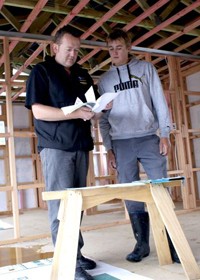 A carpenter’s ticket can be a springboard to adventures overseas, says travel enthusiast Shane Sigglekow – a Kiwi builder who has worked in England, Vanuatu and even in Antarctica.
A carpenter’s ticket can be a springboard to adventures overseas, says travel enthusiast Shane Sigglekow – a Kiwi builder who has worked in England, Vanuatu and even in Antarctica.
EIT’s Carpentry Apprentice Programme Coordinator, Shane is passionate about training the future builders of Hawke’s Bay.
“I can’t talk enough about it,” the 33-year-old enthuses. “I’m really happy to be involved.”
What he enjoys most is passing on his experience to apprentices enrolled in EIT’s Certificate in Carpentry programme. Keen to keep students on track, he stresses the employability of trade qualified builders worldwide.
“I like inspiring my students,” he grins.
On his OE, Shane found UK building companies very keen to take on qualified New Zealand carpenters. Kiwis can earn very good money, he says, with flexible employers happy to structure intensive work stints around two or three weeks of travel.
Shane started a job four days after arriving in London in 2002 and, clearing up to £1000 a week, he was able to fund travel throughout Europe and his return to New Zealand via Canada and the USA.
“Home” for Shane is Waipukurau. Growing up in Central Hawke’s Bay, he enjoyed an outdoors lifestyle – duckshooting, deerstalking, fishing and camping at the beach.
Joining the New Zealand Army as a 17-year-old, he had two years doing the “warry side of engineering”, before starting his carpentry apprenticeship.
During his eight years in the army, Shane built in the Pacific Islands – mainly in Vanuatu, where he led a team of six adding an x-ray room to a hospital on an outlying island. Locals, grateful for the help, welcomed the soldiers with a ceremonial dance, and the 100-man contingent responded with a rousing haka.
The islanders were amazed that the Kiwis would risk swimming in shark-infested waters, but Shane says a dip was a must-have after working in the tropical heat.
A challenge of the job was adapting locally available materials to suit the job. Coral, for example, replaced aggregate in cement because shingle wasn’t available – “we experimented to get the composition right”.
In the summer of 2001/02, Shane was posted to Scott Base to reclad accommodation and construct a sewage treatment plant.
“I found the Antarctic amazing and for the first couple of weeks I was blown away. It was hard to sleep with bright blue skies in the middle of the night, although windows are fitted out with blackout screens and shutters.”
In the environmentally sensitive environment, jobs that might normally take 30 minutes stretched out to two hours. Cold dry conditions stall decomposition, so sawdust was gathered up in sheeting to transport back to New Zealand and insulation panels were cut in a sealed container to prevent polystyrene bubbles being wafted away by the wind.
“The main danger is fire, the place is so dry. When you use a grinder you have to take care that there are no sparks.”
Ironically, Shane left the army to travel. He and his partner returned to New Zealand after three years away, happy to get back to Hawke’s Bay and family.
Tutoring is not such a new experience as Shane had a similar role training apprentices for the army at the School of Military Engineering.
“I think my EIT job is awesome. I’m really keen on improving the level of apprentice in Hawke’s Bay. This course is backed by the Carpentry Apprenticeship scheme set up by Certified Buildings NZ.”
EIT teaches all the theory and handles the paper work and assessments, sending detailed reports to employers and apprentices. Shane also does regular eight-weekly site visits.
“Entry is throughout the year, and of course the apprentices earn as they learn. From next year, EIT will be offering night classes to better suit busy employers.”
EIT provides two routes into a building apprenticeship.
“Either a builder has made you an offer and wants to employ you as an apprentice straight away or you could come through the EIT pre-trade course with the hope of securing employment during the work experience part of the course.”
EIT’s trades training centre offers many possibilities for developing carpentry programmes, Shane says, including building three projects simultaneously – two inside the new building.
